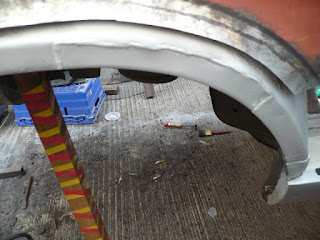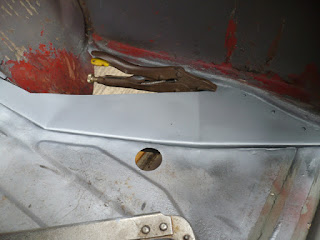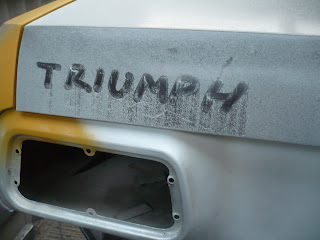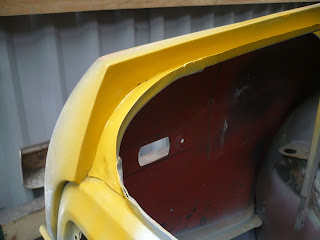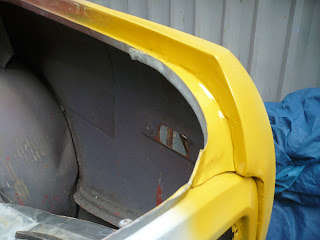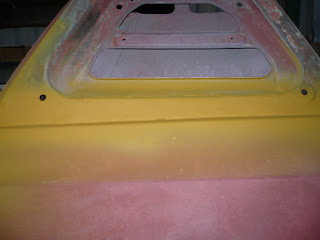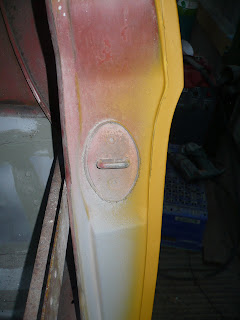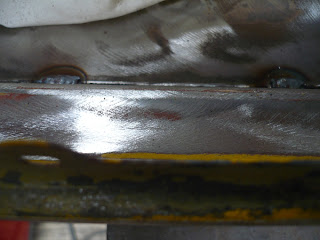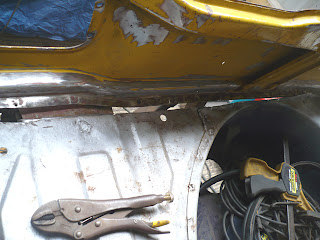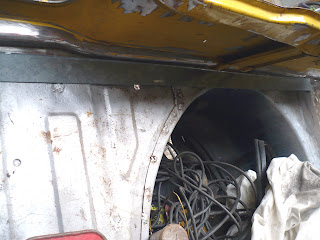Truth be told the weather over the summer made it too hot to work in the garage, which is made of metal. So now it has cooled down a bit, and I have gotten my motivation back, I decided to head back in there. It's amazing really - the welding part of this restoration is nearly over. All I had to do was carry out some repairs to the inner wheel arch on the rear near side, which was showing some nasty grot. After that, it is a case of one last - and difficult - push...the windscreen lip. But I will leave that until another day and for now tell you about this weekend.
Upon removing the paint and underseal from the inner wheel arch, just above the bit where the damper is fitted, there was quite a nasty hole. I don't have any pictures of it, but it was pretty crusty and had to be repaired. My understanding is that anything within a certain radius of suspension parts has to be seam welded, so that's what I did.
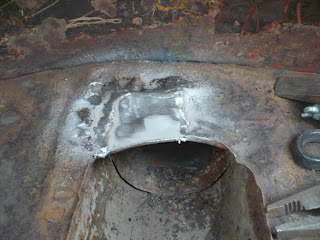 The old metal was cut out and a repair panel fabricated, which included a small 2mm lip along a curved section. I am sure Practical Classics mag would have a feature somewhere on how to do this, but I just used an old cereal packet to make a template, and left a bit extra in the cutting to form the lip. When the new metal panel was cut out, I banged the lip into shape using a former in the vice. The repair area was brought back to bare metal with the grinder, then welded in place before the welds were ground down.
The old metal was cut out and a repair panel fabricated, which included a small 2mm lip along a curved section. I am sure Practical Classics mag would have a feature somewhere on how to do this, but I just used an old cereal packet to make a template, and left a bit extra in the cutting to form the lip. When the new metal panel was cut out, I banged the lip into shape using a former in the vice. The repair area was brought back to bare metal with the grinder, then welded in place before the welds were ground down.The next job was to jut out some rot around the bottom of the inner arch, kind of where it meets the rear lower sill panel. This whole area was pitted and nasty, so I had a choice...repair lots of little holes or cut the whole lot out and do it all with one repair panel. I chose the latter method.
 Before cutting, I marked off the area that needed to come out and made a template from the remnants of the cereal box to be transferred to a sheet of new metal for cutting. Once I had the template, the marked-up area on the car was cut out using a Dremel, as access was too tight for a full sized grinder. After cutting out a few spot welds, the area came out in one lump.
Before cutting, I marked off the area that needed to come out and made a template from the remnants of the cereal box to be transferred to a sheet of new metal for cutting. Once I had the template, the marked-up area on the car was cut out using a Dremel, as access was too tight for a full sized grinder. After cutting out a few spot welds, the area came out in one lump. As is often the way with cereal box templates, they don't transfer very well to complex curvatures on metal and true to form the new panel was miles out. So, I used a blow torch to soften the new panel so that I could hammer it into place in situ for a decent fit. The method worked a treat.
As is often the way with cereal box templates, they don't transfer very well to complex curvatures on metal and true to form the new panel was miles out. So, I used a blow torch to soften the new panel so that I could hammer it into place in situ for a decent fit. The method worked a treat. The new panel was welded in place and everything dressed, before the wheel arch area itself stripped of most paint. It was then ready for a coat of zinc-rich primer.



